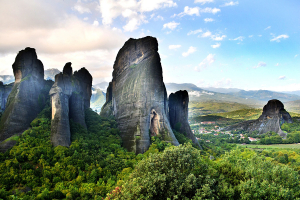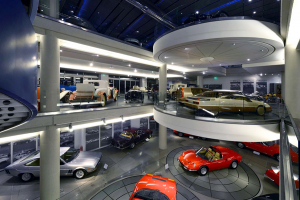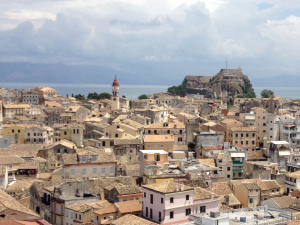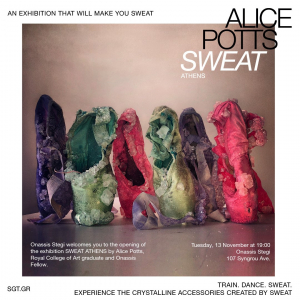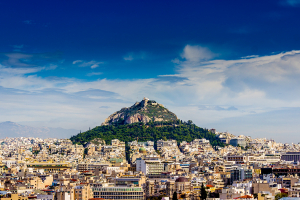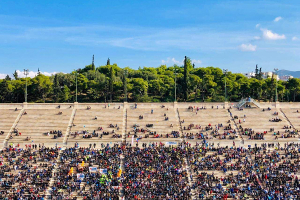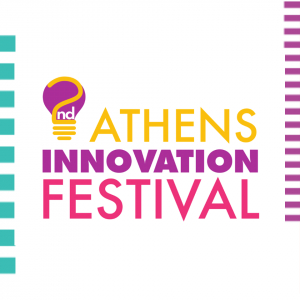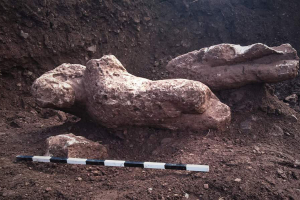SERVICES
XpatAthens
Thursday, 15 November 2018 07:00
“Greece: 365 – Day Destination” ~ The Best Tourism Film In The World for 2018
Greece is a year-round destination where every season has something special to offer; from blooming nature to out of this world beaches, and authentic traditions to fantastic winter wonderlands. The Hellenic Tourism Organization (EOT) aims to promote these less known sides of Greece with the “Greece: 365 – Day Destination” video.
The multi award-winning video, “Greece: 365 – Day Destination”, won Best Tourism Film in the World for 2018, beating 28 other nominated travel films. The Greek nomination ranked first in public preference in 136 countries, receiving almost twice as many votes as the runner-up.
The award was received, on behalf of the Greek Ministry of Tourism and the Hellenic Tourism Organization, by the creator of the video, Antonis Theocharis Kioukas and the head of EOT in Austria, Eleni Melita, at a special awards ceremony in Vienna. This distinction, is the culmination of EOT's efforts to internationally promote Greece as a world renowned year-round travel destination.
Published in
Greece In The News
Tagged under
Thursday, 15 November 2018 00:07
MBA & Masters Events In Central Athens
One-to-One Meetings with the World's Top Business Schools
Access MBA gives you the ideal opportunity to learn more about the world’s most recognised business degrees – the MBA and Executive MBA – and to speak in person with admissions directors of leading international business schools.
On the day of the Access MBA event, you will:
- Meet admissions directors during 20-minute One-to-One and small group meetings
- Take part in panel discussions featuring school representatives and alumni
- Receive advice and support from the Access MBA consulting team, as well as GMAT and scholarship information
By registering for the One-to-One MBA event, your profile will be carefully matched with the business schools that correspond to your goals and expectations – all free of charge to you. To secure your place at the event, you would be well advised to register at least 10 days before the event.
This is your opportunity to take the first step towards your MBA journey!
When: December 1st, 10:00 a.m. - 14:00
Where: Royal Olympic Hotel, Athanasiou Diakou 28
Click HERE for further details!
Where: Royal Olympic Hotel, Athanasiou Diakou 28
Click HERE for further details!
When: December 1st, 10:00 a.m. - 14:00
Where: Royal Olympic Hotel, Athanasiou Diakou 28
Click HERE for further details!
Your compass in the world of Masters education
The Access Masters Tour guides you in your search for Masters studies, directs you to the schools that best match your preferences, and connects you with some of the world’s best universities and business schools.
The Access Masters Tour is open to final-year university students and recent graduates who speak English that are interested in Masters degree study.
What can you do at the event?
- Meet with top-ranked international universities and business schools
- Get advice on Masters programmes suitable for you
- Obtain information on admission tests (TOEFL, IELTS, GMAT, GRE)
- Learn how to win scholarships and finance your Masters studies
- Take part in the draw to win a free campus visit
Where: Royal Olympic Hotel, Athanasiou Diakou 28
Click HERE for further details!
Published in
Business
Tagged under
Tuesday, 13 November 2018 07:00
Family Fun At The Hellenic Motor Museum In Athens
When the weather is rainy and cold and a walk to the park or playground isn’t possible, a visit to the Hellenic Motor Museum is an excellent alternative for a fun outing for the whole family. The Hellenic Motor Museum, that is owned by the Theodore Charagionis Foundation, first opened its doors in 2011 and has been welcoming car enthusiasts from all over the world, ever since.
The museum's collection consists of almost 300 cars (of which about 110 are displayed at a time due to space limitations) and covers more than 100 years of automotive history. In fact, the museum's oldest exhibit is a 1895 horse drawn fire engine from Hungary while the most recent exhibit is a 1996 Aston Martin DB7 Volante. Apart from its jaw dropping collection of cars, the museum is home to an authentic old car workshop, a gift shop, and a Formula 1 simulator!
The museum's collection consists of almost 300 cars (of which about 110 are displayed at a time due to space limitations) and covers more than 100 years of automotive history. In fact, the museum's oldest exhibit is a 1895 horse drawn fire engine from Hungary while the most recent exhibit is a 1996 Aston Martin DB7 Volante. Apart from its jaw dropping collection of cars, the museum is home to an authentic old car workshop, a gift shop, and a Formula 1 simulator!
The museum is located a few blocks from the National Archaeological Museum of Athens and occupies the 3 top floors at the 'Athenian Capitol' building.
Address
Address
Ioulianou 33-35 & 3is Septemvriou 74-78, Athens
Opening Hours
Opening Hours
Monday to Friday: 10:00 – 14:00
Saturday: 11:00 – 18:00
Sunday: 11:00 – 18:00
Photo Credit: Hellenic Motor Museum
Saturday: 11:00 – 18:00
Sunday: 11:00 – 18:00
Photo Credit: Hellenic Motor Museum
Published in
Kids Life
Tagged under
Tuesday, 13 November 2018 07:00
Vote For Corfu As The Best Filming Location In Europe
The Greek island of Corfu is a finalist in a competition for the best European shooting location for film and television, organized by the European Film Commissions Network (EUFCN).
All four seasons of the successful television series 'The Durrells' were filmed on the island of Corfu. According to the Hellenic Film Commission and the Greek Film Center, Corfu is one of the finalists and a strong contender for the award.
The European Film Commissions Network numbers 90 members from 30 countries and its objective is to promote European audio-visual production sites. From the 6th to the 30th of November cinema lovers can visit the Cineuropa platform and vote for Corfu!
To read this article in full, please visit: Greek Reporter
To read this article in full, please visit: Greek Reporter
Published in
Local News
Tagged under
Monday, 12 November 2018 13:20
Sweat Athens By Alice Potts - Onassis Cultural Center
Artist and recent Royal College of Art Graduate, Alice Potts states: “One day we will be able to grow our own accessories on our skin” while she exhibits in the Onassis Stegi crystalline accessories created by the sweat of dancers and athletes.
Sweat is an excretion of chemicals related to heat, passion, a reaction, a thermo regulation. A bodily fluid as yet un-examined through the eyes of Fashion or Art, Alice Potts has created an aesthetic exploration touching on the chemistry, and the beauty of this entropy. She will take her Masters’ collection of crystalline accessories from dancers and athletes and present them in a curated show by Starvos Karelis in her first moment as an Onassis fellow during the Athens Biennale in November of this year.
“One day we will be able to grow our own accessories on our skin.” Alice stated in conversation with Sarah Mower and so Alice Potts, a recent Royal College of Art Graduate, taught by Zowie Broach, now begins her fellowship programme for the Onassis Foundation.
The main focus of the work will look at the confluence of Fashion, Science and the human body. A poetry of the human fluids, sweat as art, she will begin to further study the human sporting anatomy, both inside and outside led naturally, by the history of Athens, the origins of the Olympian, the body full of blood, the maths of the sweat, that passion and examination of those extraordinary feats of athletic endeavour in a city, within our world, where the sporting, social and cultural high-lights all began.
During the Athens Biennale, Alice will present the work showcasing an alternate future of design and will be the starting point of exploring a deeper connection of her work aiming to create a new alternative and sustainable set of opportunities during her Onassis Fellowship.
Exhibition Opening: November 13th - 19:00 p.m.
Published in
Art
Tagged under
Monday, 18 January 2021 07:00
Where To Enjoy The Most Amazing Views In Athens
When you set off to discover Athens, you will be surprised by the amount of amazing vantage points the city has to offer. Due to its unique geography, Athens offers a number of places to visit and take-in the extraordinary views over the city and all the way to the sea! Get ready to feel on the top of the world at one of our favorite viewpoints in Athens.
The Acropolis
The Acropolis, Athens’ eternal landmark, offers some of the most extraordinary views in the city. Standing proudly on a high hill, the Acropolis is the most visited landmark in Athens-not only for its historical importance but also for the bird’s eye views to the city below. The Acropolis may be a rather predictable choice, however, it is the most stunning location in Athens if not in the whole of Greece.
The Acropolis, Athens’ eternal landmark, offers some of the most extraordinary views in the city. Standing proudly on a high hill, the Acropolis is the most visited landmark in Athens-not only for its historical importance but also for the bird’s eye views to the city below. The Acropolis may be a rather predictable choice, however, it is the most stunning location in Athens if not in the whole of Greece.
Mount Lycabettus
Lycabettus is the highest peak in Athens and an iconic landmark of the city. At 300 meters above sea level it offers unsurpassed views of the city; on a clear day, you can see the island of Aegina shimmering in the horizon. The top of the hill can be reached by foot, but the easiest way to get there is via the cable car that runs every half hour from the station on Aristippou street. Mount Lycabettus is home to the picturesque chapel of St. George, a restaurant, and an open air theater. The views from the hill are particularly amazing at night time!
Lycabettus is the highest peak in Athens and an iconic landmark of the city. At 300 meters above sea level it offers unsurpassed views of the city; on a clear day, you can see the island of Aegina shimmering in the horizon. The top of the hill can be reached by foot, but the easiest way to get there is via the cable car that runs every half hour from the station on Aristippou street. Mount Lycabettus is home to the picturesque chapel of St. George, a restaurant, and an open air theater. The views from the hill are particularly amazing at night time!
Philopappou Hill
Named after the monument of Philoppapos that was discovered in the area, this hill captures Greek history, ancient and modern in a single image. Walking up the marble paved path and you will pass the tiny church of St. Dimitrios Loumbardiaris and The Shrine of the Muses which is cut into the rock just below the hill’s summit. From the top of the you’ll be able to take some amazing pictures of the Parthenon, the Odeon of Herodes Atticus, the Acropolis Museum, and the Athens Observatory. The hill is surrounded by a beautiful park and is a favorite kite drifting spot on the Greek Kathara Deytera - Clean Monday holiday.
Named after the monument of Philoppapos that was discovered in the area, this hill captures Greek history, ancient and modern in a single image. Walking up the marble paved path and you will pass the tiny church of St. Dimitrios Loumbardiaris and The Shrine of the Muses which is cut into the rock just below the hill’s summit. From the top of the you’ll be able to take some amazing pictures of the Parthenon, the Odeon of Herodes Atticus, the Acropolis Museum, and the Athens Observatory. The hill is surrounded by a beautiful park and is a favorite kite drifting spot on the Greek Kathara Deytera - Clean Monday holiday.
Other excellent places to savor awe-inspiring views of central Athens are: Strefi Hill near Exarhia, the Athens National Observatory on Nymphon Hill, and Areopagus Hill near the Acropolis. If you have some extra time on your hands we highly recommend taking the short trip to the floodlit Temple of Poseidon in Sounion to watch the sun set into the Saronic Gulf and the moon rising up over the sea!
This content has been sourced and prepared by Codico Lab
Published in
City Discovery
Tagged under
Monday, 12 November 2018 07:00
The 36th Athens Authentic Marathon Ends With Great Success
The 36th Athens Authentic Marathon was held with great success yesterday, November 11th. This year the race brought together more than 55,000 runners from 106 countries. The 42,195m race is more than just a sporting event, it’s a tribute to Greek history, human willpower, solidarity, friendship, and social responsibility. A total of 18,70 runners took part in the historic Marathon race, while thousands joined the 3 & 5 & 10 kilometer road races, the kids' fun runs, and the Special Olympics Hellas Fun Run.
It was a great day for Kenyan runners since both the mens and womens marathon races were won by Kenyan nationals. Brimin Kipkorir won the mens Marathon in 2 hours, 10 minutes, 56 seconds and Shelmith Muriuki of won the womens race in 2 hours, 36 minutes, 46 seconds.
The Marathon area is of great historical significance, as it was the site of the famous Marathon battle that took place in 490 BC. After the battle was won by the Greeks, a soldier named Pheidippides was sent to Athens to deliver the news. Pheidippides ran all the way to Athens and managed to say, "We have won," before he collapsed and died. That was the first marathon in history and to this day the runners of the Athens Authentic Marathon follow the exact same route.
'The legend continues. Each year the Athens Marathon gets better and better,' said Paco Borao, President of AIMS, the Association of International Marathons and Distance Races, at the press conference for the 'Athens Marathon. The Authentic.'
The city of Athens looks forward to welcoming even more runners from around the world for the Athens Authentic Marathon in 2019!
Photo Credit: @chromecabrio
The city of Athens looks forward to welcoming even more runners from around the world for the Athens Authentic Marathon in 2019!
Photo Credit: @chromecabrio
Published in
Greece In The News
Tagged under
Friday, 09 November 2018 10:01
Canadian Film Screening~ The Canadian Institute In Greece
“Rumble: The Indians Who Rocked the World”
This award-winning Canadian documentary profiles the impact of Indigenous musicians in Canada and the United States on the development of popular music (blues, jazz, folk, pop, rock, heavy metal). Artists profiled include Charley Patton, Mildred Bailey, Link Wray, Jimi Hendrix, Jesse Ed Davis, Stevie Salas, Buffy Sainte-Marie, Robbie Robertson, Randy Castillo, Taboo and others.
The title of the film is a reference to the pioneering instrumental "Rumble", released in 1958 by the American group Link Wray & His Ray Men. The instrumental piece was very significant for many artists. The film features many influential musicians who discuss the musical contributions of Indigenous artists, including commentaries from Quincy Jones, George Clinton, Taj Mahal, Martin Scorsese, John Trudell, Steven Tyler, Marky Ramone, Slash, Iggy Pop, Buddy Guy and others.
This award-winning Canadian documentary profiles the impact of Indigenous musicians in Canada and the United States on the development of popular music (blues, jazz, folk, pop, rock, heavy metal). Artists profiled include Charley Patton, Mildred Bailey, Link Wray, Jimi Hendrix, Jesse Ed Davis, Stevie Salas, Buffy Sainte-Marie, Robbie Robertson, Randy Castillo, Taboo and others.
The title of the film is a reference to the pioneering instrumental "Rumble", released in 1958 by the American group Link Wray & His Ray Men. The instrumental piece was very significant for many artists. The film features many influential musicians who discuss the musical contributions of Indigenous artists, including commentaries from Quincy Jones, George Clinton, Taj Mahal, Martin Scorsese, John Trudell, Steven Tyler, Marky Ramone, Slash, Iggy Pop, Buddy Guy and others.
Published in
Community
Tagged under
Friday, 09 November 2018 00:29
Athens Innovation Festival 2018
A celebration of innovation and entrepreneurship!
During November 12-14, Zappeion becomes the ultimate meeting point for businesses, startups, universities, private and public institutions.
Two days devoted to innovation and technological developments and opportunities to learn everything you need to know regarding education, networking and dynamic synergies.
Representatives from emerging and acclaimed businesses, investors, researchers, academics and government agencies will be present through interactive discussions, workshops, parallel presentations, and interviews.
Exhibitors from the most emerging industries, from agri-food and health, to fitech and e-commerce, come to showcase next-big-things and bring with them all the experience and know-how.
Top companies that generate value, create jobs and have a significant footprint and outside of Greece come to meet promising startups.
Published in
Community
Tagged under
Thursday, 08 November 2018 07:00
4 Ancient Greek Statues Unearthed Near The Town Of Atalanti
The Ministry of Culture announced that 4 ancient statues were discovered in a field in Atalanti, central Greece, last week. Archaeologists began excavation works in the area in late October, after a local farmer discovered the torso of an ancient statue in his field. The excavation brought to light a collection of important relics, namely, 4 life-sized statues of nude young men (also known as Kouroi), 7 graves, and a statue pedestal dating back to the 5th-2nd centuries BC.
The town of Atalanti has been inhabited since antiquity and is the capital of the Locris province, where the ancient city of Opus once stood. Archaeologists suggest that an ancient cemetery may located around the area where the statues were discovered and believe that it is likely to be the cemetery of the ancient city of Opus.
To read this article in full, please visit: Greek Travel Pages
Published in
Local News
Tagged under

